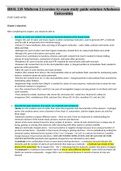Biol 235 chapter 8 Study guides, Class notes & Summaries
Looking for the best study guides, study notes and summaries about Biol 235 chapter 8? On this page you'll find 20 study documents about Biol 235 chapter 8.
Page 2 out of 20 results
Sort by
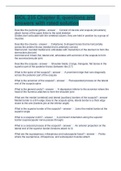
-
BIOL 235 Chapter 8, questions and answers with rated solution
- Exam (elaborations) • 7 pages • 2023
-
Available in package deal
-
- $11.49
- + learn more
BIOL 235 Chapter 8, questions and answers with rated solution Describe the pectoral girdles Consist of clavicle and scapula (shoulders); attach bones of the upper limbs to the axial skeleton Girdles don't articulate with the vertebral column, they are held in position by a group of muscles Describe the clavicle Collarbone; S-shaped bones that lie horizontally across the anterior thorax (medial end is anteriorly convex) Sternal end: rounded medial end, articulates with manubrium of t...
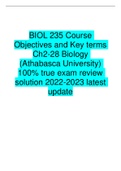
-
BIOL 235 Course Objectives and Key terms Ch2-28 Biology (Athabasca University) 100% true exam review solution 2022-2023 latest update
- Exam (elaborations) • 170 pages • 2022
-
Available in package deal
-
- $14.49
- + learn more
BIOL 235 Course Objectives and Key terms Ch2-28 Biology (Athabasca University) 100% true exam review solution 2022-2023 latest update BIOLOGY 235 HUMAN ANATOMY AND PHYSIOLOGY Study Guide Chapter 2 The Chemical Level of Organization Objectives After completing this chapter, you should be able to 1. identify, by name and symbol, the principal chemical elements of the human body. 2. describe the basic structure of an atom, ion, molecule and compound. 3. explain, briefly, how ioni...

-
BIOL 235 CHAPTER 1 – INTRODUCTION TO THE HUMAN BODY,BIOL 235 CHAPTER 2 – THE CHEMICAL LEVEL OF ORGANIZATION, BIOL 235 CHAPTER 3 – THE CELLULAR LEVEL OF ORGANIZATION, BIOL 235 CHAPTER 4- THE TISSUE LEVEL OF ORGANIZATION, BIOL 235 CHAPTER 5 – INTEGUMENTARY,
- Package deal • 9 items • 2022
-
- $17.49
- + learn more
BIOL 235 CHAPTER 1 – INTRODUCTION TO THE HUMAN BODY,BIOL 235 CHAPTER 2 – THE CHEMICAL LEVEL OF ORGANIZATION, BIOL 235 CHAPTER 3 – THE CELLULAR LEVEL OF ORGANIZATION, BIOL 235 CHAPTER 4- THE TISSUE LEVEL OF ORGANIZATION, BIOL 235 CHAPTER 5 – INTEGUMENTARY, BIOL 235 CHAPTER 7 – THE SKELETAL SYSTEM: THE AXIAL SKELETON, BIOL 235 CHAPTER 8 – THE SKELET
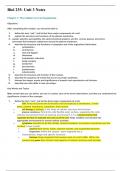
-
Biol 235- Unit 3 Notes Chapter 3: The Cellular Level of Organization
- Exam (elaborations) • 44 pages • 2023
-
- $9.99
- + learn more
Biol 235- Unit 3 Notes Chapter 3: The Cellular Level of Organization Objectives After completing this chapter, you should be able to 1. define the term “cell,” and list the three major components of a cell. 2. explain the structure and functions of the plasma membrane. 3. explain selective permeability, the electrochemical gradient, and the various passive and active processes that transport substances across the plasma membrane. 4. describe the structure and functions of cytopla...
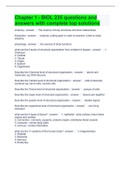
-
Chapter 1 - BIOL 235 questions and answers with complete top solutions
- Exam (elaborations) • 6 pages • 2023
-
Available in package deal
-
- $11.49
- + learn more
Chapter 1 - BIOL 235 questions and answers with complete top solutions Anatomy The science of body structures and their relationships Dissection analysis; cutting apart in order to examine. Used to study anatomy physiology the science of body functions what are the 6 levels of structural organization from smallest of largest. 1. Chemical 2. Cellular 3. Tissue 4. Organ 5. System 6. Organismal Describe the Chemical level of structural organization. atoms and ...
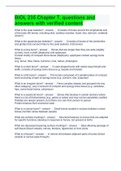
-
BIOL 235 Chapter 7, questions and answers with verified content
- Exam (elaborations) • 9 pages • 2023
-
Available in package deal
-
- $10.99
- + learn more
BIOL 235 Chapter 7, questions and answers with verified content What is the axial skeleton? Consists of bones around the longitudinal axis of the body (80 bones, including skull, auditory ossicles, hyoid, ribs, sternum, vertebral column) What is the appendicular skeleton? Consists of bones of the extremities and girdles that connect limbs to the axial skeleton (126 bones) What is a long bone? Bones that are longer than they are wide (slightly curved), have a shaft (diaphysis) a...

-
BIOL 235 Final Exam Guide
- Exam (elaborations) • 41 pages • 2022
-
- $12.99
- + learn more
BIOL 235 Final Exam Guide. Chapter 19 The Cardiovascular System: The Blood Objectives After completing this chapter, you should be able to 1. describe the functions of blood. 2. describe the physical characteristics and principal components of blood. 3. list the major components of plasma and explain their importance. 4. explain the origin of blood cells. 5. describe the structure, functions, life cycle and production of red blood cells. 6. describe the structure, functions and produc...
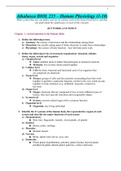
-
BIOL 235 – Human Physiology Keywords and topics Chapters (1-10)Athabasca
- Exam (elaborations) • 96 pages • 2022
-
- $19.99
- + learn more
Athabasca BIOL 235 – Human Physiology (1-10) Make certain that you can define, and use in content, each of the terms listed below, and that you understand the significance of each of the concepts. KEY WORDS AND TOPICS Chapter 1: An Introduction to the Human Body 1. Define the following terms: a) Anatomy: the science of structures and the relationships among them b) Dissection: the careful cutting apart of body structures to study their relationships c) Physiology: the science of b...
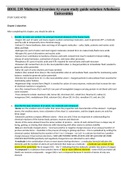
-
BIOL 235 Midterm 2 (version A) exam study guide solution Athabasca Universities STUDY GUIDE NOTES
- Summary • 17 pages • 2021
-
- $14.49
- + learn more
BIOL 235 Midterm 2 (version A) exam study guide solution Athabasca Universities STUDY GUIDE NOTES BIOL 235 Midterm 2 (version A) exam study guide solution Athabasca Universities STUDY GUIDE NOTES Chapter 2 objectives After completing this chapter, you should be able to 1. Identify, by name and symbol, the principal chemical elements of the human body. -Oxygen (O): part of water and many organic (carbon-containing) molecules; used to generate ATP, a molecule used by cells to tempora...

Did you know that on average a seller on Stuvia earns $82 per month selling study resources? Hmm, hint, hint. Discover all about earning on Stuvia



